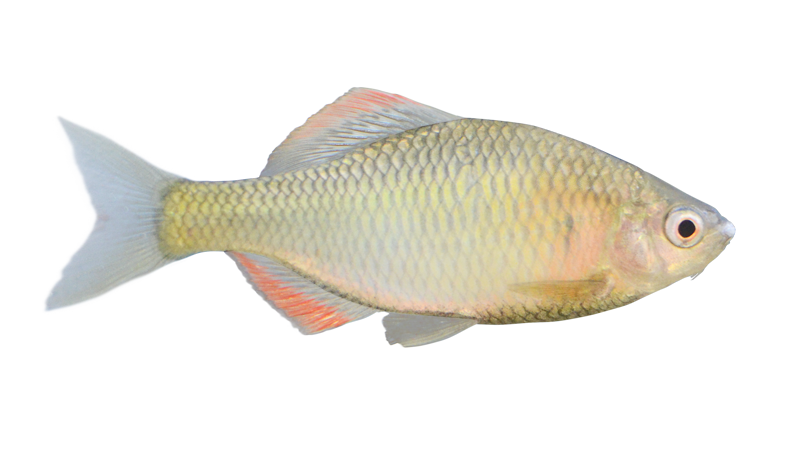
Tanakia lanceolata (Temminck & Schlegel, 1846)
関東では絶滅?ヤリタナゴ
Is the Slender Bitterling Extinct in the Kanto Region?
全長10cm。日本産タナゴ類のなかで最も分布域が広く、北海道と九州南部を除く日本各地に分布しています。国外では朝鮮半島西部と中国遼寧省に分布しています。主に河川の中〜下流域や農業用水路などの流れのある淡水域に生息しており、付着藻類や底生の小動物を餌とする雑食性の小魚です。
タナゴ類の中では流線型で細長く、口ヒゲが長いのが特徴で、その体型が和名の由来であり、学名も「槍のタナゴ」という意味です。他のタナゴと同様に繁殖期の雄には婚姻色が現れます。地域によって差がありますが、一般的には体色が暗緑色になり、エラ蓋後部が色鮮やかなピンク色に染まり、背ビレと尻ビレ、尾ビレの内側が黒く、縁が朱色になります。
ヤリタナゴには7つの遺伝的に異なる地域固有グループが存在しているのですが、関東地方では他地域からの人為移植によって深刻な遺伝的撹乱が起こっています。古くからヤリタナゴの生息記録があり自然分布域と考えられてきた関東地方固有の遺伝子は失われ、近畿地方や東海地方の遺伝子に置き換わっていることが近年の研究で分かりました。また、ヤリタナゴ自体も近縁種であるアブラボテとの交雑が進んでおり、種の存続と多様性を守るために遺伝子保全対策が求められています。
It measures 10 cm in length. It has the widest distribution of all Japanese bitterlings, found throughout Japan except Hokkaido and southern Kyushu. Outside Japan, it is found in the western Korean Peninsula and Liaoning Province, China. It primarily inhabits flowing freshwater areas such as the mid- to lower reaches of rivers and irrigation channels. It is an omnivorous small fish that feeds on attached algae and small benthic animals.
Among bitterlings, it is characterized by its streamlined, slender body shape with long barbels. This body shape is the origin of its Japanese name, and its scientific name means “spear bitterling.” Like other bitterlings, males exhibit nuptial coloration during the breeding season. While this varies by region, the body color generally becomes dark green, the posterior part of the gill cover turns a vibrant pink, and the insides of the dorsal, anal, and caudal fins become black with vermilion edges.
There are seven genetically distinct endemic populations of the spear bitterling. However, in the Kanto region, serious genetic disturbance has occurred due to artificial transplantation from other regions. Recent research has shown that the genes specific to the Kanto region, where the Japanese bitterling has long been recorded and thought to be its natural distribution, have been lost and replaced by genes from the Kinki and Tokai regions. Furthermore, the Japanese bitterling itself is increasingly hybridizing with its closely related species, the oil-striped tuna, and genetic conservation measures are needed to protect the survival and diversity of the species.
参考文献
京都府 | 京都府レッドデータブック2015 | ヤリタナゴ 2025年8月14日閲覧
おおさか環農水研 | 図鑑 | ヤリタナゴ 2025年8月14日閲覧
たなごGo! | ヤリタナゴの特徴・外観・飼育・繁殖・釣り情報を詳しく解説! | (2024年4月16日) 2025年8月14日閲覧
「愛媛県特定希少野生動植物 ヤリタナゴ保護管理事業計画」愛媛県庁自然保護課 (2023年7月15日) 2025年8月14日閲覧